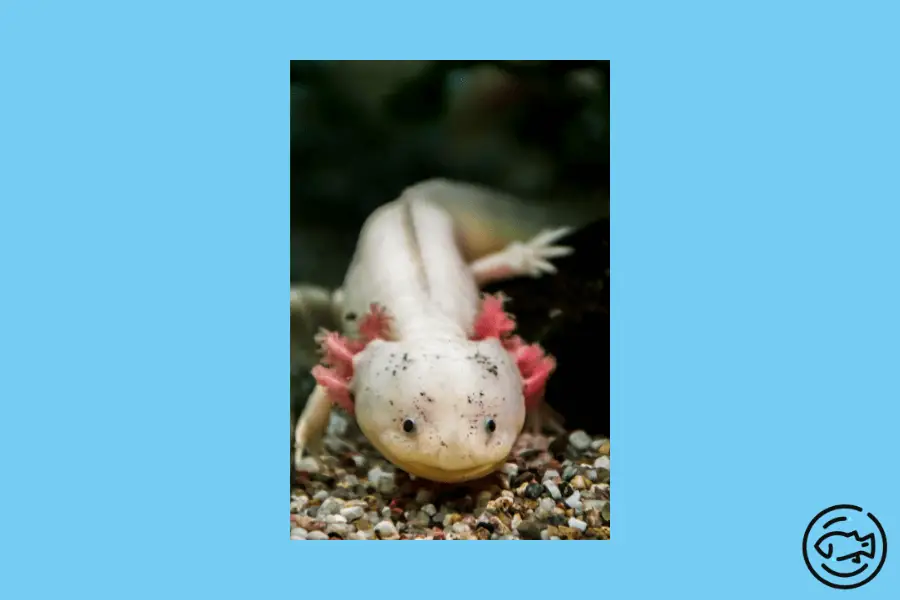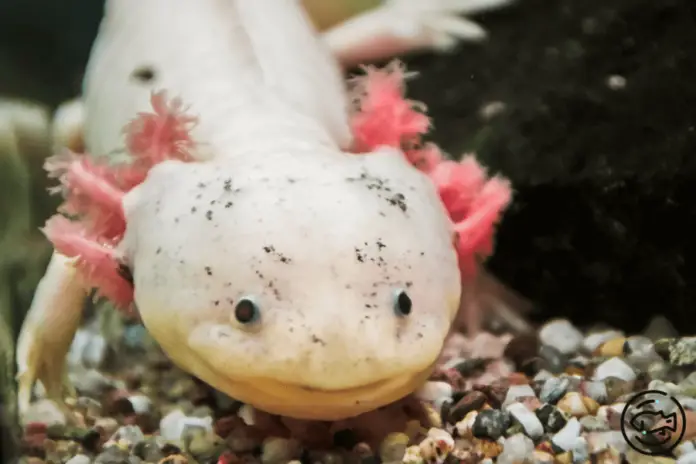Beautifully ethereal, leucistic axolotls are a sight to see as they are pale pink or white instead of their wild kin’s ordinarily black and brown. Even though they are sometimes referred to as albino axolotls, this is technically incorrect since true albinism is a hereditary disorder that causes the entire lack of pigmentation.
On the other hand, leucism causes just a portion of the skin to lose its color. Pet leucistic axolotls have the same extended lifespan and resilience as their wild ancestors. They must have a large amount of water to swim and hide in their aquarium.
They are carnivores, like other axolotls, and will devour anything that fits in their jaws.
Leucistic axolotls are just as exciting and unusual as their wild relatives, despite lacking the vibrant colors that characterize them. Any fortunate owner will get plenty of use out of them for years.
The Physical Traits Of Leucistic Axolotl

The leucistic axolotl is a salamander with an albino appearance. Gills, which resemble hair and are white or transparent, protrude from their heads.
They are the same species of axolotls despite their apparent differences in appearance.
Leucistic axolotls live in the same freshwater lakes and ponds throughout Mexico as their more typical counterparts. Small fish, worms, and insects make up the bulk of their diet.
They first need a well-filtered aquarium with lots of hiding places. Secondly, they need live food like worms or little fish. Last but not least, they are sensitive to water quality fluctuations. Therefore, it is crucial to carefully check their tank and provide a constant, clean water supply.
The Diet Of Leucistic Axolotl
Axolotls are opportunistic eaters who consume whatever they may find in the wild. This includes insects, plants, and other little creatures. However, in captivity, their food is far more constrained.
Earthworms, bloodworms, and brine shrimp are examples of live foods that should be included in a leucistic axolotl’s diet. They must be fed daily, and their size should determine the quantity. As a general rule, give them as much food as they can consume in one sitting.
These axolotls should eat live food, although they can also be fed frozen or freeze-dried items. However, because they are less nutrient-dense than live food, they should only be given seldom.
You must ensure your axolotl is appropriately gut-loaded before feeding it any food. This means that to ensure the meal is nutrient-dense, it should be served to another animal first. Your axolotl will more likely remain healthy and develop to its full potential if you do this.
Breeding Leucistic
When trying to breed a Leucistic Axolotl, there are numerous factors to consider.
First, check for sickness and make sure the fish are in good health, and the standard of the water supply is the next factor to examine.
All of the water needs to be pure and safe to drink, and the fish’s dietary requirements are the final factor to think about.
Breeding these axolotls is a simple process as after the male fish have fertilized the eggs, the female will lay them. In around two weeks, the eggs will hatch, and in about six months, the fry can be reintroduced into the wild.
There is no other fish quite like the stunning and rare Leucistic Axolotl. Due to its unique albino coloring, it is frequently kept in aquariums and terrariums. The breeding potential of this fish has made it a popular choice.
Tank Requirements
Leucistic axolotls, first and foremost, need a large tank, and they require open water in which they can swim and explore.
As a general guideline, each axolotl should have access to 10 gallons of water every day. In addition, the axolotls’ aquarium enclosure must have a secure lid.
The water quality can have a significant impact on these axolotls as their tank water must be purified and changed often to ensure their health.
Keeping the water at a steady temperature is also crucial as they are native to Mexico, leucistic axolotls thrive in waters between 68°F & 72°F.
Because of their solitary nature, these axolotls are best housed singly or in small groups of their kind. Although they are generally peaceful, they may resort to violence if they feel threatened.
Last but not least, these axolotls require a high-protein diet.
As carnivores, they feast on live prey, including worms, insects, and even tiny fish. To ensure they’re getting all the nutrients, providing a wide range of dietary options is crucial.
The Lifespan Of Leucistic Axolotl
Axolotls are a kind of salamander with the remarkable ability to regrow lost body parts and organs, including limbs, the spinal cord, and the heart.
Both as household pets and in the realm of science, they have widespread popularity in the United States.
These axolotls are a highly unusual subspecies of the axolotl that lack skin pigmentation. This causes a lot of them to be very white or pale. Although they share many characteristics with albino axolotls, they do not have albinism since they retain some eye pigmentation.
Generally speaking, the average lifetime of a leucistic axolotl is between 10 and 15 years. On the other hand, these axolotls have been known to live for over 20 years. They have the potential to live much longer in captivity if they get the proper care.
These axolotls, like their more common relatives, are carnivores who like to feast on live prey. Its natural prey includes worms, insects, and tiny fish. Live or frozen meals, such as bloodworms, brine shrimp, and krill, are available for them to eat while in captivity.
What Is The Going Rate For Leucistic Axolotls?
A Leucistic Axolotl may get anywhere from $20 to $100 on the open market. The size, age, and condition of the animal affect the asking price.
Prices for Axolotls vary depending on their size and age, and a higher price tag goes hand in hand with a higher-grade animal.
Because of their relative rarity compared to Axolotls of other color morphs, these axolotls may be challenging to track down. However, many breeders now provide them since they are gaining in popularity.
Are Leucistic Axolotls Friendly?
There are many diverse viewpoints on whether or not leucistic axolotls are friendly. There is a divide in opinion on whether or not these animals are safe to keep as pets, with some holding the view that they are friendly and tame.
I feel leucistic axolotls may be friendly and aggressive, depending on their particular dispositions. Some axolotls I’ve seen were friendly and tame, while others were far more hostile. It truly depends on the particular axolotl and how it is grown.
If you are contemplating obtaining a leucistic axolotl as a pet, I suggest studying their care and personality features beforehand. In this manner, you may find a axolotl that will thrive in your home.
Conclusion
Therefore, the leucistic axolotl is a stunning and rare amphibian. This absence of skin pigmentation does not make them people with albinism but makes them seem incredibly pale.
Despite their relative rarity compared to other axolotl hues, they may be easily found in the pet industry. Whether an axolotl expert or a beginner, you’ll love having a leucistic axolotl as a pet.




[…] also read: Leucistic Axolotl – Everything You Need To Know! […]